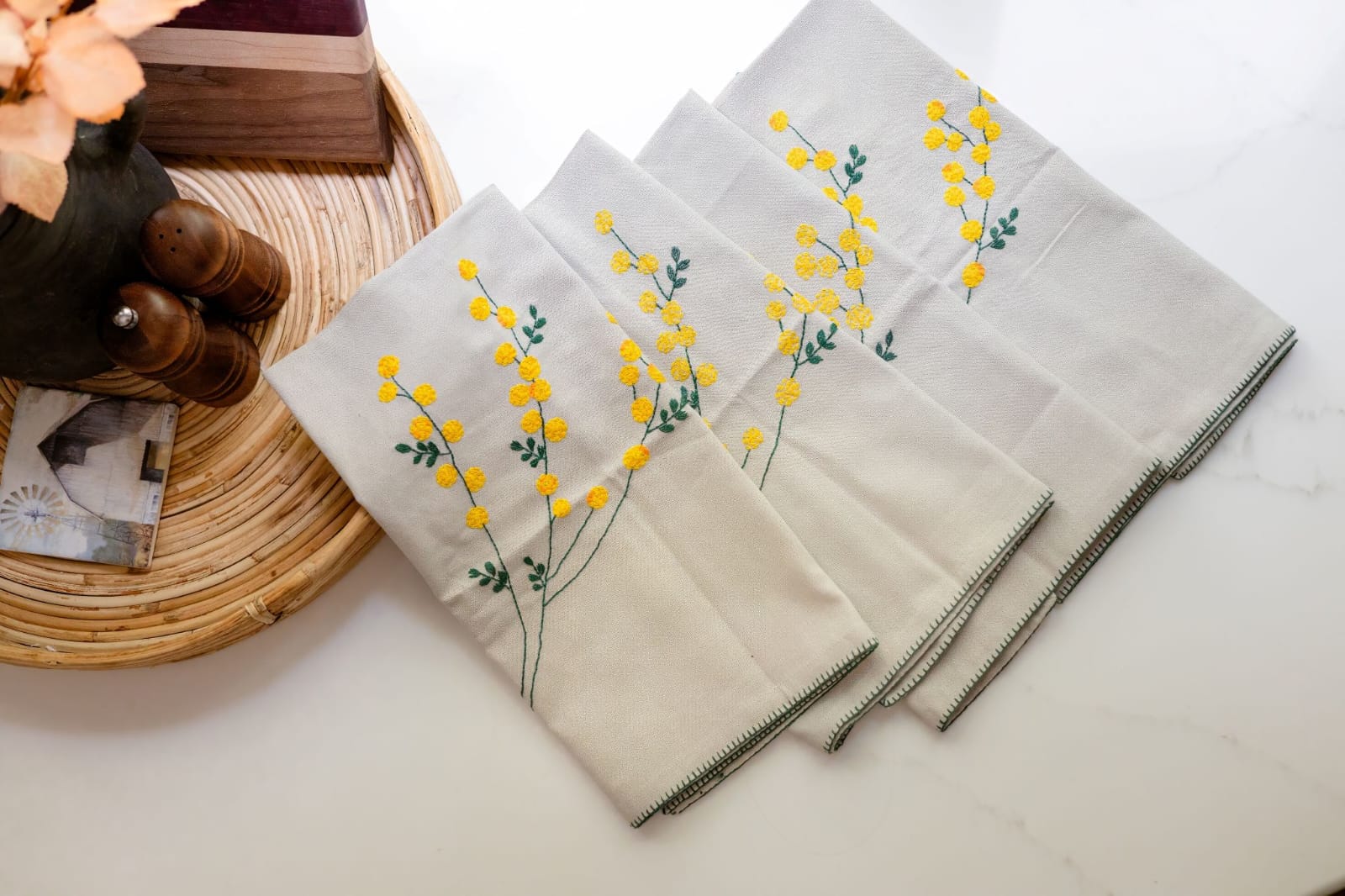Kathya's Sorghum Field, Cinder flower and Golden Thatch Tea Towels-showcasing traditional Chain and Herringbone stitches
In the vibrant world of Indian handicrafts, few speak with the visual rhythm and cultural depth of Lambadi embroidery. More than just fabric and thread, it is a tapestry of nomadic history, ritual symbolism, and feminine expression—often carrying deeper meaning, through motifs reflecting fertility, protection, and/or prosperity. This makes every piece not just decorative, but deeply meaningful.
At Kathya, we honor this age-old folk art, by working directly with ‘Lambadi’ artisan groups, upholding their deep and rich embroidery tradition, while reimagining them for everyday use in modern homes and lifestyle. Through our carefully handcrafted totes, tea towels, and cushion covers, we seek to translate this language of stitches passed down through generations of Lambadi women, into meaningful pieces that resonate globally.
The Past in Motion
The Lambadi or Banjara community traces its origins to the nomadic tribes of Rajasthan and other northern parts of India. Over time, groups of Lambadi's migrated southwards, settling in the Deccan region.
Historically, Lambadi women practiced embroidery as a form of personal expression and cultural preservation. Since they didn’t have a written script, embroidery became a language of its own—used to decorate their garments, communicate social status, and express personal stories or emotions. The craft was passed down from mother to daughter, evolving subtly with each generation.
Traditional garments like the 'skirt' ('Phetiya'), the 'blouse' ('Kanchli'), and a head scarf ('Chaniya') were heavily embroidered with mirror work, beadwork, appliqué, and a wide repertoire of stitch styles.

Lambadi Women in Traditional Wear (Photo Courtesy: Retlaw Snellac Photography)
Over the years, Lambadi embroidery has shifted from being strictly functional and community-based to becoming a recognized handicraft in the commercial market. While Lambadi women no longer wear traditional garments, except during ceremonial occasions, their embroidery continues to thrive.
Modern adaptations of this craft form often tone-down the mirror and beadwork, while elevating some of the most prominent stitching styles. These adaptations often make way into products such as handbags, pouches, cushion covers, garments, and even jewelry.
 Modern Interpretations for Jewelry-Photo Courtesy Jency Samuel/villagesquare.in
Modern Interpretations for Jewelry-Photo Courtesy Jency Samuel/villagesquare.in
The Lambadi Look
Lambadi embroidery is rich in symbolic meaning, with its motifs reflecting both aesthetic beauty and cultural significance. Dominated by bold geometric patterns like diamonds, triangles, and chevrons, the embroidery creates a striking visual rhythm. Alongside these shapes, nature-inspired motifs—such as flowers, birds, trees, and the sun—add a vibrant, organic touch to the designs.
At Kathya, we take inspiration directly from these motifs—particularly bringing into our product natural elements such as leaves, flowers, birds, dragonflies, as well as grains. 
Kathya's Meadow Queen Tote-inspired by Field Barley Flowers
The Stitch Styles
A Depiction of the Different Stitches-Courtesy Porgai Artisans
Lambadi embroidery features a wide repertoire of stitches, each with specific applications and visual impact. Some prominent stitch styles include:
- Running Stitch: Used for outlining and borders, often visible in our minimal tea towel designs.
- Chain Stitch: Perfect for curved lines and floral elements, frequently seen in our tote bags.
- Herringbone Stitch: Adds lattice-like texture, also visible in our more visually complex napkins.
- Appliqué Work: We incorporate fabric-on-fabric detailing in bold accents on our cushion covers.
- Buttonhole Stitch: Adds strength and visual appeal, especially around appliqué
- Satin Stitch: Fills bold motifs with rich color, lending depth and vibrancy.
Kathya's Daisy Daydream Throw Pillow Cover-with signature Running and Buttonhole stitches with Appliqué Work
Our Artisan Partners
Our exemplary artisans belong to the Lambadi tribes living in villages in Dharmapuri and Tiruvannamalai districts of Tamil Nadu, South India. They have grown into a collective of 60 artisans called 'The Porgai Artisans Association' helmed by Dr. Lalitha Regi. 'Porgai' signifies pride in their craft and dignity from the income they gain.
“It is as though we have got our voices back. Now we have a sense of solidarity and an outlet for our creativity.” (Thaikulam, President of the Association)
Continuing the Legacy
Lambadi embroidery is more than an aesthetic—it's a living tradition stitched with pride, resilience, and identity. At Kathya, each product is but a chapter in that story, lovingly crafted by the hands that carry this legacy forward. By choosing handmade, you don't just support a product—you celebrate a culture, a community, and a tradition that refuses to fade.
Join us in deconstructing the ordinary and discovering the extraordinary—one stitch at a time. Explore our Serenestitch Collection.




